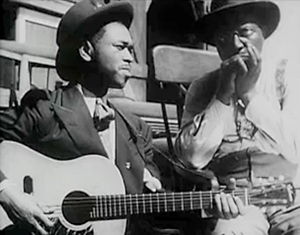“The Library of Congress,” a 20-minute motion picture from the 1940s, is blessed with a special mojo. It is not only a loving homage to the Library, rich with Hollywood production values, but it is also associated with a few significant nodes in history: World War II, the creation of the Library’s motion picture archives and the population of cyberspace with cultural treasure.
The motion picture is a pleasure to watch. It has great dignity and pride, despite a few outdated stylistic touches and narrative statements, and it attempts to convey the Library’s significance, its roots in American history and its reach into international collections.
It unfolds through a voice-over narration by actor Ralph Bellamy and a moving camera that wanders the ornate Jefferson building, panning through the Great Hall and the reading room. From there the motion picture drifts through the halls, stacks and exhibition halls. The Declaration of Independence, Bill of Rights and Constitution are featured (they’ve since been moved to the National Archives), as are the Guttenberg bible and rare Beethoven and Mozart manuscripts.
The American Folklife Center collections are represented by two unique outdoor field-recording moments. The first is the recording of blues musicians Sonny Terry and Brownie McGhee performing “Red River Blues.” In the second field recording, Woody Guthrie performs “Ranger’s Command.” The audio from the field recordings is shown being cut directly to disks.
Back at the Library, the visit ends with the camera tracking into the Coolidge Auditorium during a performance by the Budapest String Quartet, most likely playing on the Library’s Stradivariuses, performing Beethoven‘s Op. 59 no. 3, in C, 4th movement “Allegro molto.”
In the decade before “The Library of Congress” was produced, the Library was not actively involved in the acquisition and preservation of motion pictures. But that changed after 1939 when poet and writer Archibald MacLeish was appointed Librarian of Congress.

Librarian of Congress Archibald MacLeish. CREDIT: Washington Press Photo-Bureau, photographer. "Photograph of Archibald MacLeish," Manuscript Division, Library of Congress. Call Number Location: Number 1359.
World War II had as much to do with MacLeish’s development of a national film collection at the Library of Congress as did any reasons of artistic or cultural merit. MacLeish served as director of the War Department’s Office of Facts and Figures and as assistant director to the Office of War Information, which presented positive images of the United States to an international audience.
The OWI worked with major Hollywood talent — producers, directors, writers, composers, actors and technicians — to create motion pictures that represented American ideals; the State Department used OWI films to explain the American way of life to the peoples of Allied and neutral nations and to describe the U.S. role in the war. The OWI produced “The Library of Congress” in 1945 as part of the American Scene series to showcase the services the Library provides to legislators, scholars and libraries around the world.
The government’s WWII involvement with — and support of — motion pictures helped establish an environment in which the Library could develop a national film repository. Through the Library of Congress Film Project, MacLeish arranged for the Library to work with the Rockefeller Foundation and the Museum of Modern Art to archive and conduct scholarly analyses of motion pictures, presumably to preserve them as records of American history and culture. According to an MBRS administrative history report,
“In 1942 the Library received a Rockefeller Foundation grant to establish a national motion picture collection and the Motion Picture Section was formed to administer the selection of motion pictures for the Library’s permanent collection, seek additional important acquisitions, and develop a method for preserving the motion picture copyright registrations received prior to 1912.”
And so, the Library of Congress’s motion picture collections became official.
“The Library of Congress” motion picture eventually was preserved by the Library’s Motion Picture, Broadcasting & Recorded Sound division, along with other OWI productions in its collections. The MBRS Division will be digitizing and digitally archiving the motion picture at the Library’s new state-of-the-art Packard Campus for Audio Visual Conservation in Culpeper, Virginia. Other copies of the film have also been digitized and made available for all to enjoy online. The Academy of Motion Picture Arts & Sciences, one of the Library’s NDIIPP partners, has placed a digital copy online as part of its War Film Collection. Another print, digitized by FedFlix, which promotes public access to United States Government movies, can be viewed on the Internet Archive.
“The Library of Congress” motion picture began its life as a circulating wartime motion picture, showcasing of one of America’s greatest institutions. Then it helped populate and enrich that same institution’s early motion picture collections.
Now it is available online for anyone to enjoy, not only as a dignified “home movie” of the library from 1943 but also as a digitized slice of culture, transcending the restrictions of time (watch it anytime) and space (watch it anywhere that you have an Internet connection).
Regard it as another just digital video residing in cyberspace — which is still an amazing modern phenomenon — or as a national heirloom. Either way it’s delightful.


